Thermal Management of Diesel Engine Aftertreatment System Based on Ultra-Low Nitrogen Oxides Emission
Abstract
:1. Introduction
2. Method
2.1. EAT System Experiments
2.1.1. Test Bench Structure
2.1.2. Cycle Experiments
2.2. Modeling
2.2.1. Chemical Model
- De-NOx Reactions inside SCR
- 2.
- Reactions inside DOC
2.2.2. EAT System Model
3. Result and Analysis
3.1. SCR Reaction at Steady Working Point
3.2. SCR Reaction at Transient Cycle
3.3. Effect of DOC on SCR
4. Discussion
5. Conclusions
- At lower exhaust temperatures, the NH3–NOx reactions were hindered by the low temperature, which is consistent with the article mentioned in [8]. As exhaust temperature increases, the NOx conversion rate gradually increases from 87.07% at 200 °C to 97.81% at 260 °C. Longer SCR carriers can also increase the NH3–NOx reaction rate at steady working points at the cost of higher capital cost and ammonia chemical loss, as mentioned in [10].
- A separate LO-SCR coupled with an upstream electrical heater can effectively increase the NOx conversion rate at lower exhaust temperatures. With a 7.2 kW electrical heater, the NOx emission at the LO-SCR outlet decreased by 45% during the 200~500 s of the WHTC cycle.
- The effect of DOC on the NH3–NOx reactions is twofold. At lower working points, partially oxidized NO into NO2 increases the proportion of fast reaction in LO-SCR, while, at higher load working points, the high NO2 proportion may increase N2O generation and the proportion of slow reaction, similar to those mentioned in [21,22]. The upstream DOC decreased the LO-SCR outlet NOx emission by 63% during the 200~500 s of the WHTC cycle at the cost of worse cold-start performance and higher N2O emission.
- The application of thermal management increased the average exhaust temperature, which increased the NH3–O2 reaction rate in SCR. The urea input shall be adjusted properly to avoid NOx emission during the latter part of WHTC, as mentioned in [10].
Author Contributions
Funding
Institutional Review Board Statement
Informed Consent Statement
Data Availability Statement
Acknowledgments
Conflicts of Interest
Nomenclature
| A | Pre-exponential factor |
| b | Positive constants |
| E (kJ/mol) | Activation energy |
| LO-SCR | Light-Off Selective Catalyst Reduction |
| NOx | Nitrogen Oxides |
| HC | Hydrocarbon |
| WHTC | World Harmonized Transient Cycle |
| WHSC | World Harmonized Stationary Cycle |
| DOC | Diesel Oxidation Catalyst |
| EAT | Exhaust Aftertreatment |
| CDPF | Catalytic Diesel Particulate Filter |
| SCR | Selective Catalytic Reduction |
| ASC | Ammonia Slip Catalyst |
| VGT | Variable Geometry Turbocharger |
| ULN | Ultra-Low Nitrogen Oxides |
| CLD | Chemiluminescence Detector |
| PMD | Paramagnetic Detector |
References
- Lelieveld, J.; Evan, J.S.; Fnais, M.; Giannadaki, D.; Pozzer, A. The contribution of outdoor air pollution sources to premature mortality on a global scale. Nature 2015, 525, 367–371. [Google Scholar] [CrossRef] [PubMed]
- Johnson, T.; Joshi, A. Review of Vehicle Engine Efficiency and Emissions. SAE Int. J. Engines 2018, 11, 1307–1330. [Google Scholar] [CrossRef]
- Hooftman, N.; Messagie, M.; Van Mierlo, J.; Coosemans, T. A review of the European passenger car regulations—Real driving emissions vs local air quality. Renew. Sustain. Energy Rev. 2018, 86, 1–21. [Google Scholar] [CrossRef]
- Zavala, B.; Sharp, C.; Neely, G.; Rao, S. CARB Low NOx Stage 3 Program—Aftertreatment Evaluation and Down Selection; No. 2020-01-1402; SAE Technical Paper: Warrendale, PA, USA, 2020. [Google Scholar] [CrossRef]
- Pan, Y.J.; Shen, B.X.; Liu, L.J.; Yao, Y.; Gao, H.P.; Liang, C.; Xu, H.J. Develop high efficient of NH3-SCR catalysts with wide temperature range by ball-milled method. Fuel 2020, 282, 118834. [Google Scholar] [CrossRef]
- Metkar, P.S.; Harold, M.P.; Balakotaiah, V. Experimental and kinetic modeling study of NH3-SCR of NOx on Fe-ZSM-5, Cu-chabazite and combined Fe- and Cu-zeolite monolithic catalysts. Chem. Eng. Sci. 2013, 87, 51–66. [Google Scholar] [CrossRef]
- Mohan, S.; Dinesha, P.; Kumar, S. NOx reduction behaviour in copper zeolite catalysts for ammonia SCR systems: A review. Chem. Eng. J. 2020, 384, 123253. [Google Scholar] [CrossRef]
- Lei, Y.; Liu, C.; Guo, D.; Yang, J.; Qiu, T.; Peng, G. Real-Time Evaluation Method of Heavy-Duty Diesel Vehicle SCR System Based on Ammonia Storage Characteristics in Real-Road Driving Emission Test. Appl. Sci. 2022, 12, 11197. [Google Scholar] [CrossRef]
- Gholami, F.; Tomas, M.; Gholami, Z.; Vakili, M. Technologies for the nitrogen oxides reduction from flue gas: A review. Sci. Total Environ. 2020, 714, 136712. [Google Scholar] [CrossRef] [PubMed]
- Xie, L.; Jiang, G.; Qian, F. Experimental Research on Aftertreatment SCR Sizing Strategy for a Nonroad Mid–Range Diesel Engine. Energies 2020, 13, 4462. [Google Scholar] [CrossRef]
- Ciardelli, C.; Nova, I.; Tronconi, E.; Chatterjee, D.; Bandl-Konrad, B. A “Nitrate Route” for the low temperature “Fast SCR” reaction over a V2O5–WO3/TiO2 commercial catalyst. Chem. Commun. 2004, 23, 2718–2719. [Google Scholar] [CrossRef] [PubMed]
- Yang, X.G.; Ma, Q.; Niu, G.P.; Xu, X.T. Effect of fast SCR reaction on denitration characteristics of commercial V2O5-WO3/TiO2 catalysts. Chin. J. Environ. Eng. 2018, 12, 1968–1976. [Google Scholar]
- Yao, D.W.; Liu, B.A.; Wu, F.; Li, Y.X.; Hu, X.H.; Jin, W.Y.; Wang, X.L. N2O Formation Mechanism During Low-Temperature NH3-SCR over Cu-SSZ-13 Catalysts with Different Cu Loadings. Ind. Eng. Chem. Res. 2021, 60, 10083–10093. [Google Scholar] [CrossRef]
- Kim, M.H.; Park, S.W. Selective reduction of NO by NH3 over Fe-zeolite-promoted V2O5-WO3/TiO2-based catalysts: Great suppression of N2O formation and origin of NO removal activity loss. Catal. Commun. 2016, 86, 82–85. [Google Scholar] [CrossRef]
- Sharp, C.; Zavala, B.; Neely, G.; Rao, S. An Update on Continuing Progress towards Heavy-Duty Low NOx and CO2 in 2027 and Beyond; No. 2023-01-0357; SAE Technical Paper: Warrendale, PA, USA, 2023. [Google Scholar] [CrossRef]
- Imdadul, H.K.; Masjuki, H.H.; Kalam, M.A.; Zulkifli, N.W.M.; Alabdulkarem, A.; Rashed, M.M.; Teoh, Y.H.; How, H.G. Higher alcohol–biodiesel–diesel blends: An approach for improving the performance, emission, and combustion of a light-duty diesel engine. Energy Convers. Manag. 2016, 111, 174–185. [Google Scholar] [CrossRef]
- Jung, Y.J.; Pyo, Y.; Jang, J.; Woo, Y.; Ko, A.; Kim, G.; Shin, Y.; Cho, C. Nitrous oxide in diesel aftertreatment systems including DOC, DPF and urea-SCR. Fuel 2021, 310, 122453. [Google Scholar] [CrossRef]
- Jiao, P.H.; Li, Z.J.; Shen, B.X.; Zhang, W.; Kong, X.J.; Jiang, R. Research of DPF regeneration with NOx-PM coupled chemical reaction. Appl. Therm. Eng. 2017, 110, 737–745. [Google Scholar] [CrossRef]
- Bai, S.Z.; Tang, J.; Wang, G.H.; Li, G.X. Soot loading estimation model and passive regeneration characteristics of DPF system for heavy-duty engine. Appl. Therm. Eng. 2016, 100, 1292–1298. [Google Scholar] [CrossRef]
- Nova, I.; Ciardelli, C.; Tronconi, E.; Chatterjee, D.; Weibel, M. Unifying Redox Kinetics for Standard and Fast NH3-SCR over a V2O5-WO3/TiO2 Catalyst. AIChE J. 2009, 55, 1514–1529. [Google Scholar] [CrossRef]
- Bai, S.Z.; Han, J.L.; Liu, M.; Qin, S.S.; Wang, G.H.; Li, G.X. Experimental investigation of exhaust thermal management on NOx emissions of heavy-duty diesel engine under the world Harmonized transient cycle (WHTC). Appl. Therm. Eng. 2018, 142, 421–432. [Google Scholar] [CrossRef]
- Li, Y.; Zhu, Y.; Zhang, N.; Liu, Z. Simulation of Denitrification of Vehicle Exhaust over Cu-CHA Bazite Catalyst for a Monolith Reactor. Catalysts 2021, 11, 930. [Google Scholar] [CrossRef]
- Liu, B.; Yao, D.W.; Wu, F.; Wei, L.; Li, X.W.; Wang, X.L. Experimental Investigation on N2O Formation during the Selective Catalytic Reduction of NOx with NH3 over Cu-SSZ-13. Ind. Eng. Chem. Res. 2019, 58, 20516–20527. [Google Scholar] [CrossRef]
- Hsieh, M.F.; Wang, J.M. NO and NO2 Concentration Modeling and Observer-Based Estimation Across a Diesel Engine Aftertreatment System. J. Dyn. Syst. Meas. Control Trans. ASME 2011, 133, 041005. [Google Scholar] [CrossRef]
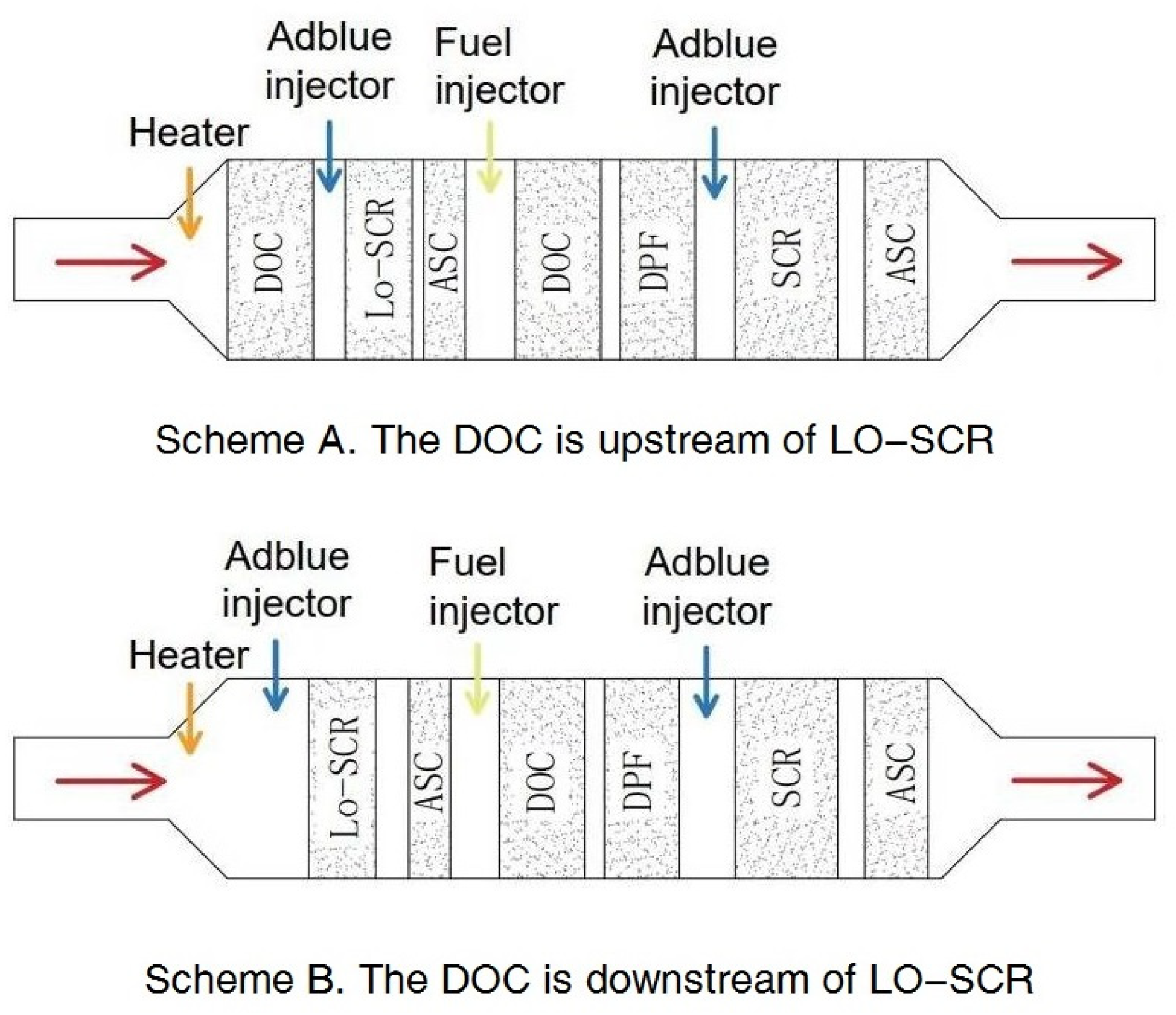
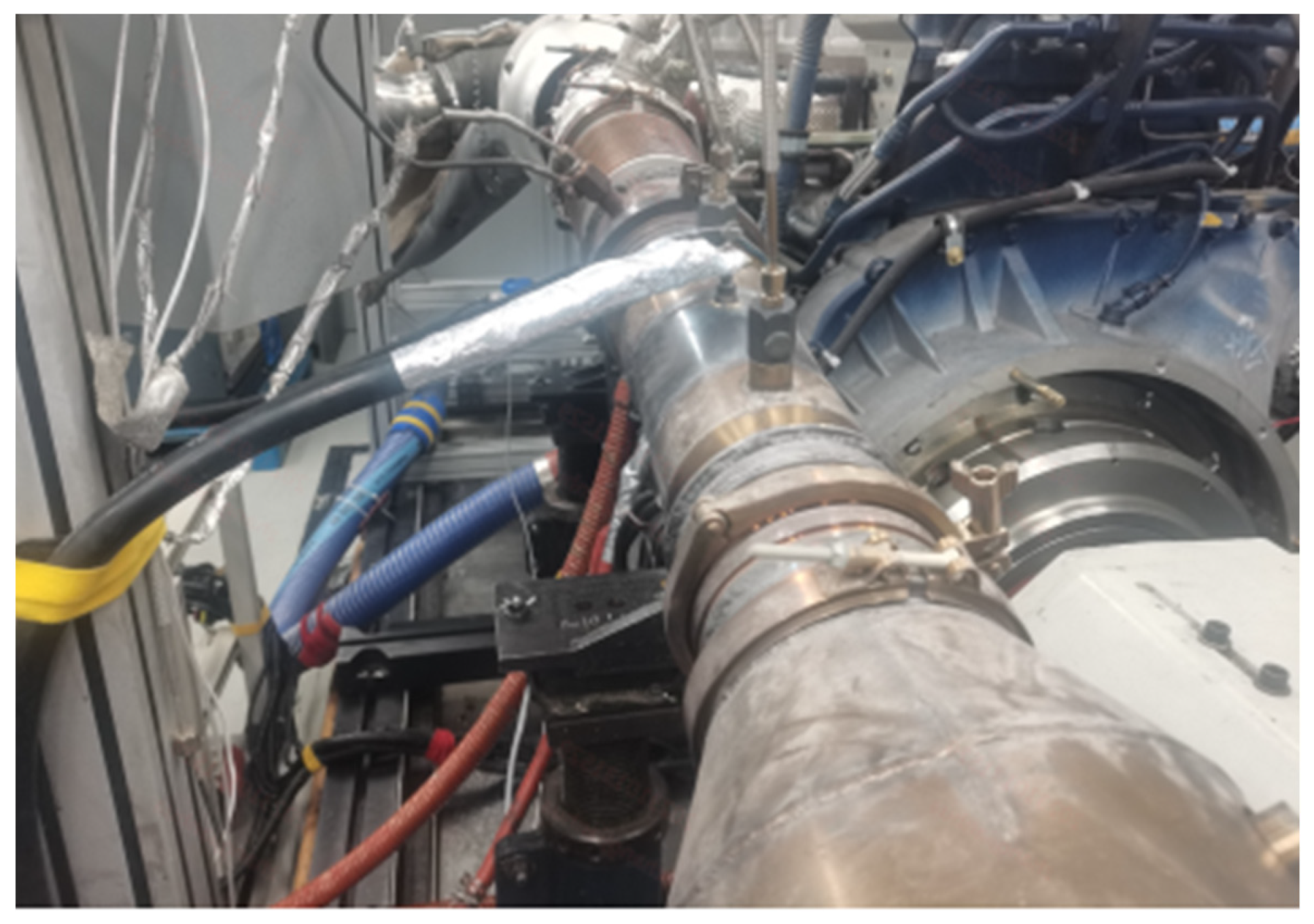
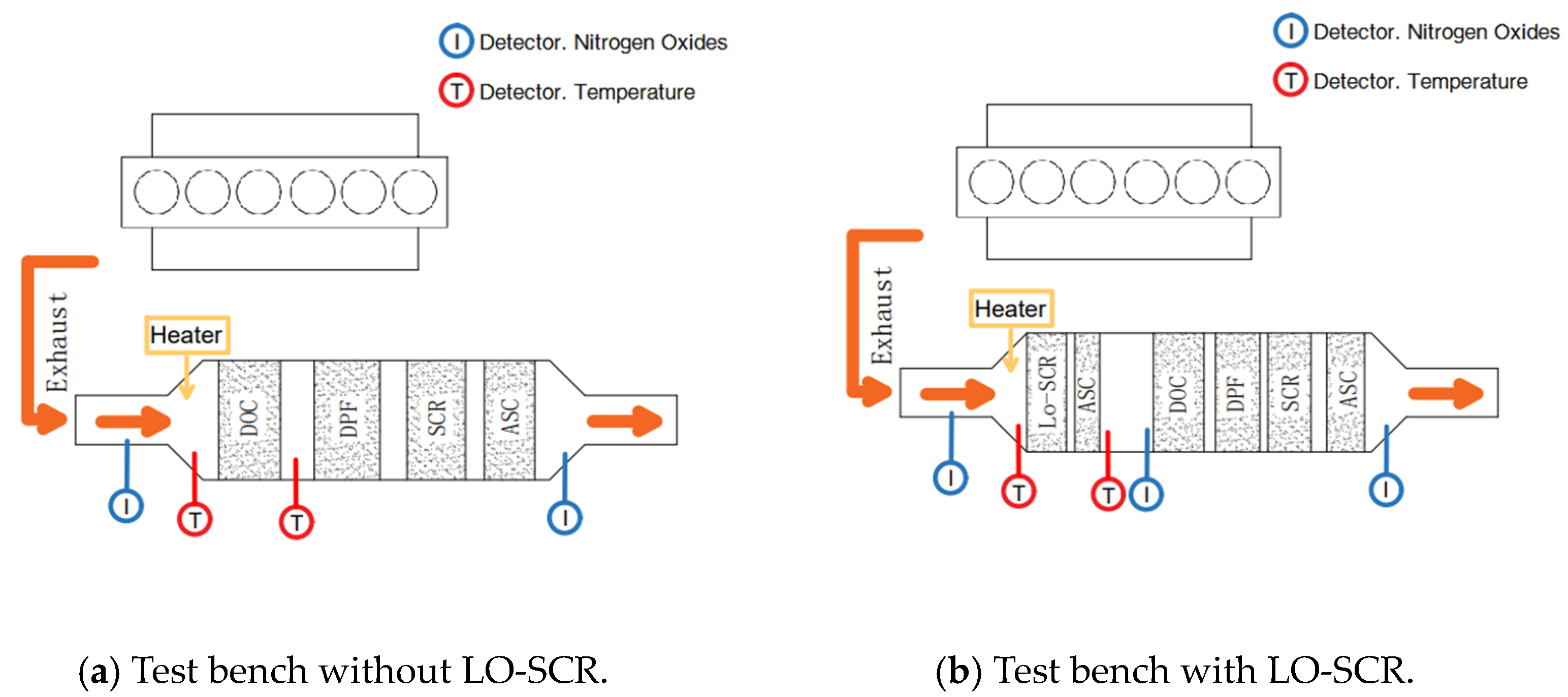

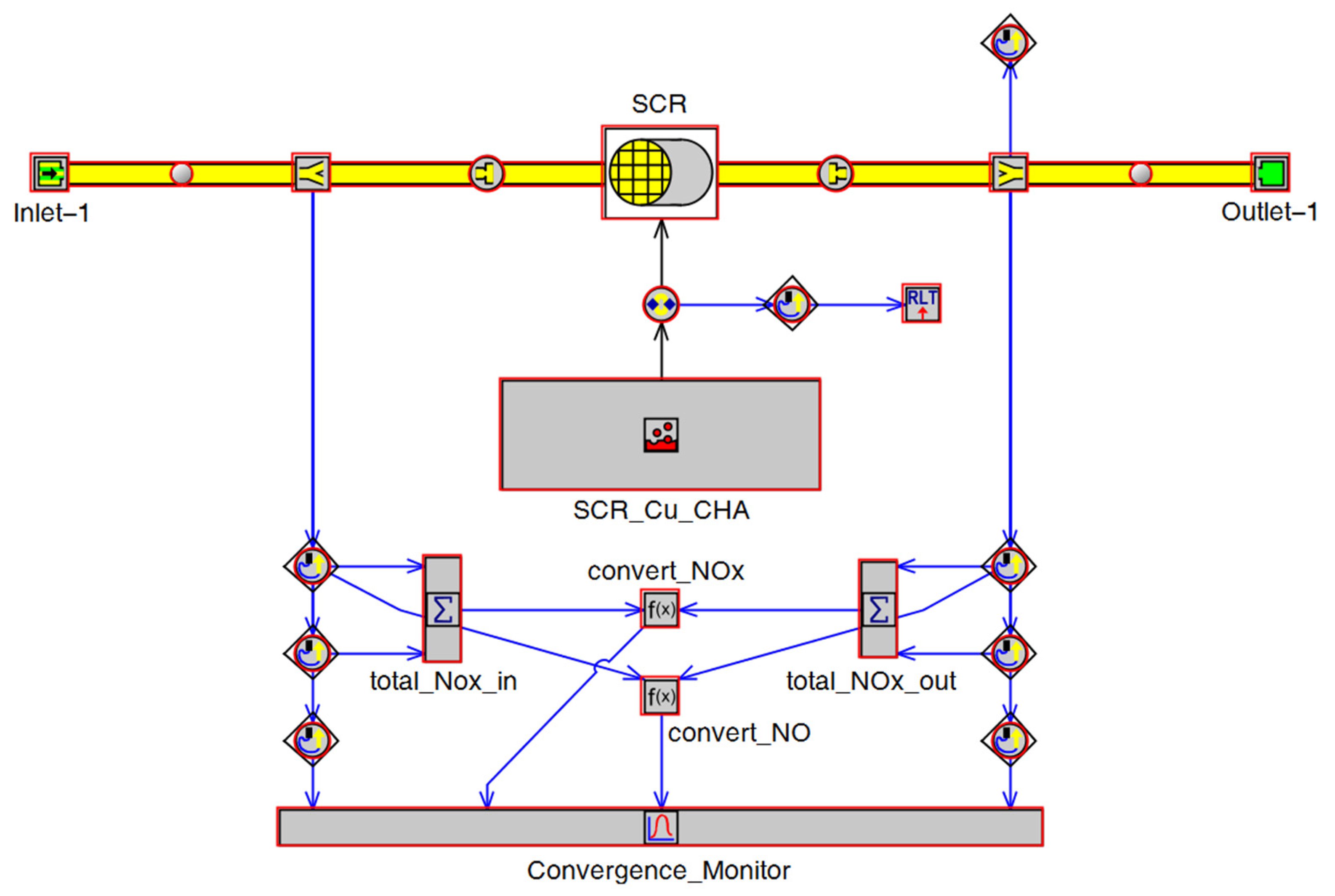



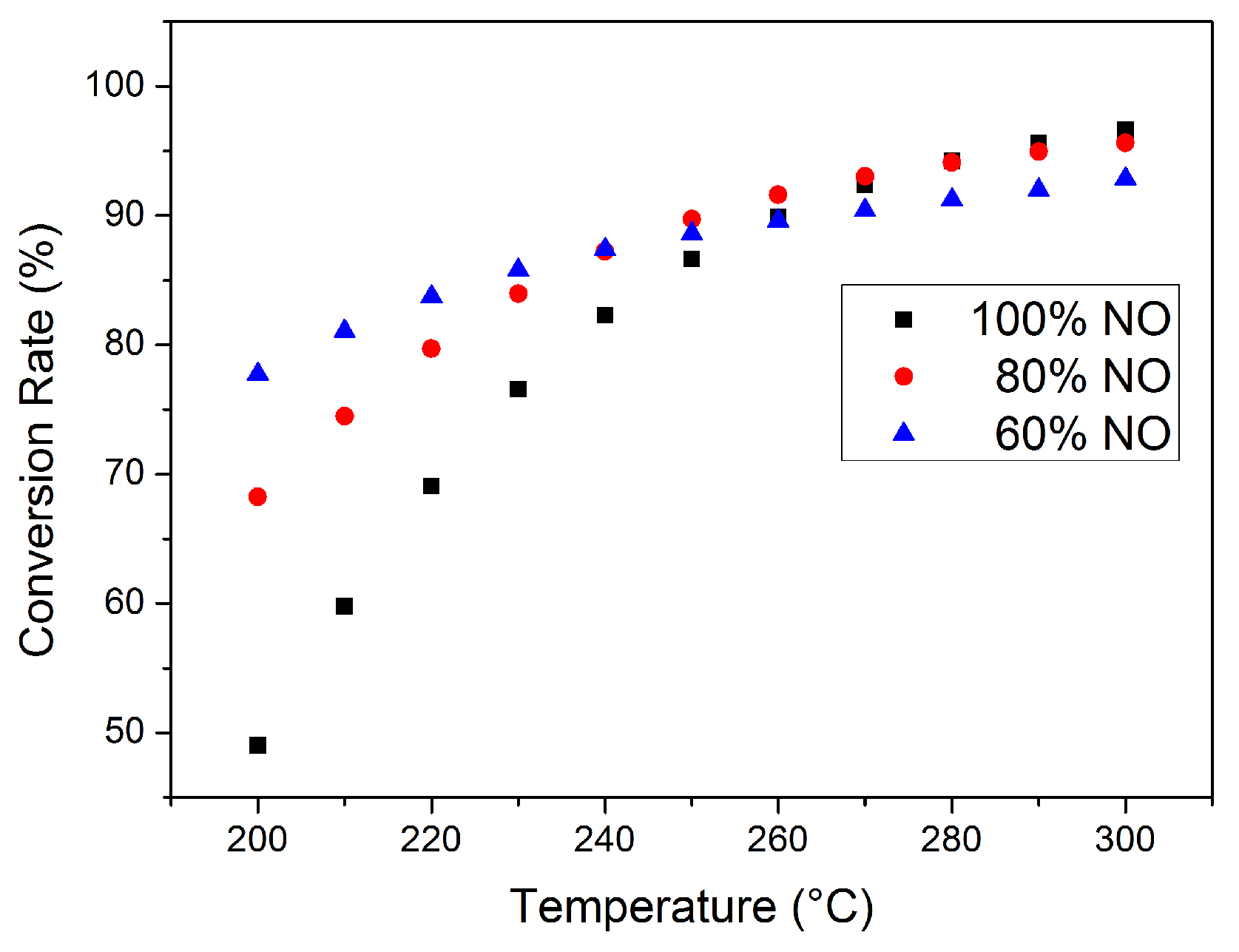
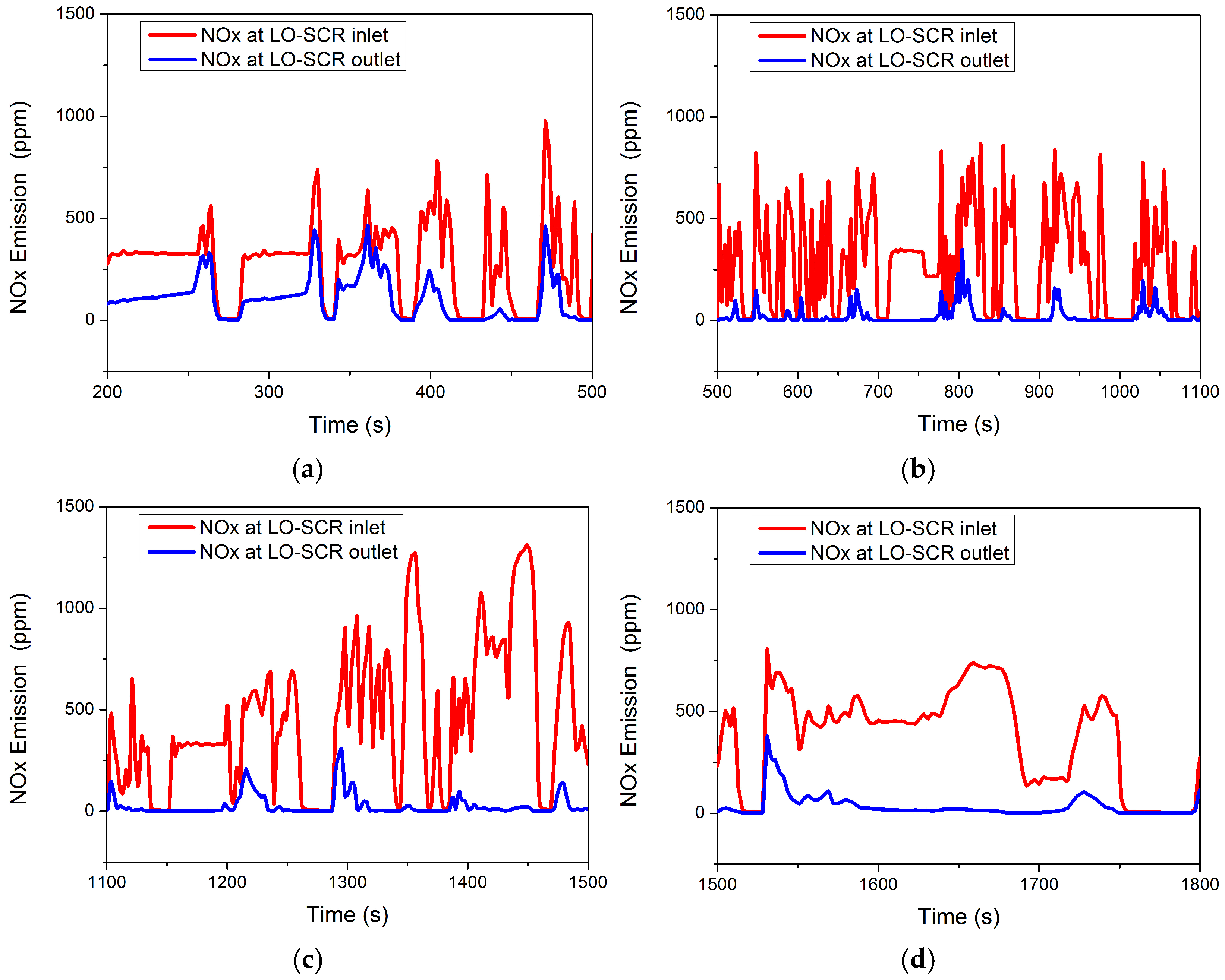


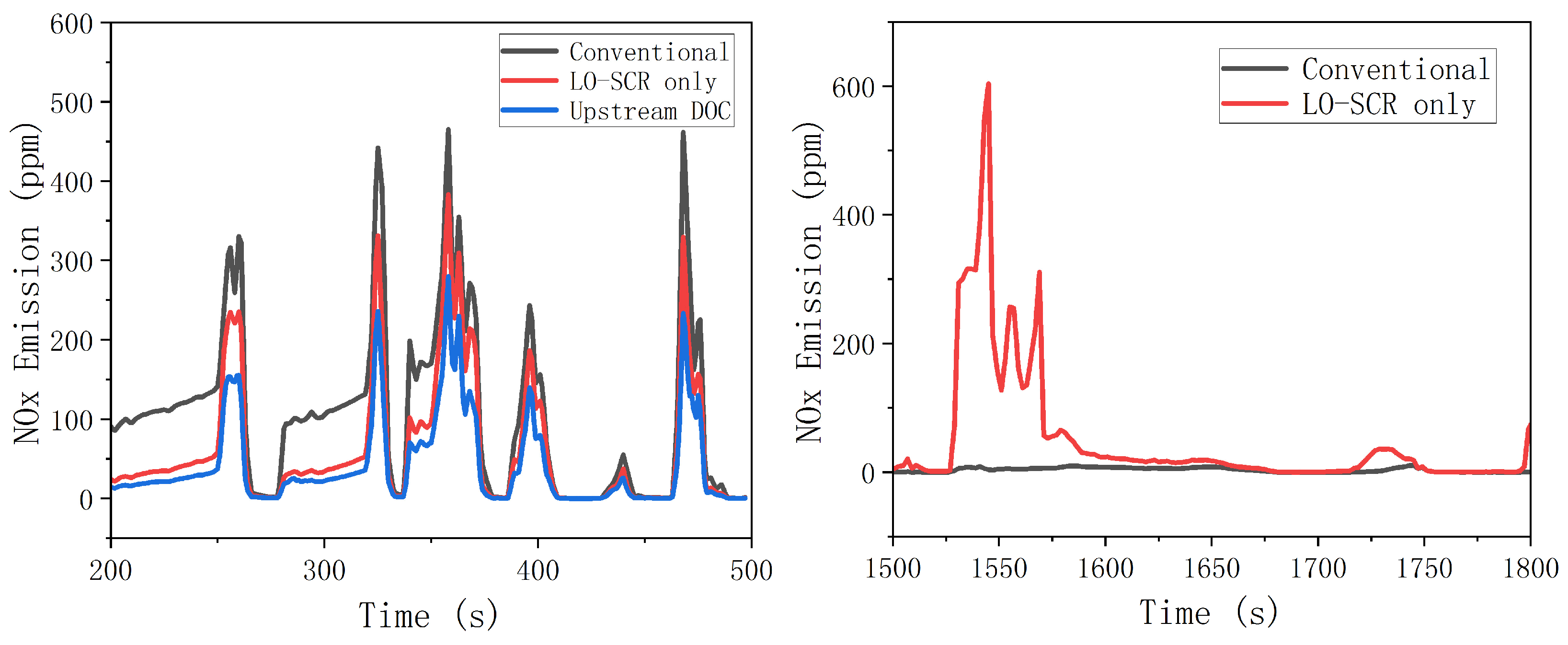
| Project | Specification |
|---|---|
| Engine type | 6-cylinder in-line/inter-cooling |
| Bore × Stroke/mm × mm | 117 × 135 |
| Displacement/L | 8.7 |
| Rated power/kW | 280 |
| Rated speed/r/min | 2100 |
| Idle speed/r/min | 700 |
| EGR rate | 0 |
| Turbocharger | VGT |
| Equipment | Model | Measuring Principle | Accuracy of Measurement |
|---|---|---|---|
| Electric dynamometer | INDYS66JD | - | Speed: ±1 r/min |
| Torque: ±0.1%FS | |||
| Exhaust gas analyser | I60 | NOx: CLD | 1 ppmvol |
| O2: PMD | 0.01%vol | ||
| Opacimeter | 483 | Photoacoustic method | 5 μg |
| Fuel consumption meter | FC2212L | - | ±0.2% |
| Thermocouple | RTD100 | - | 1 °C |
| No. | Reactions | A | b | E (kJ/mol) |
|---|---|---|---|---|
| R1 | NH3 + S → NH3-S | 6.68 × 107 | 0 | 0 |
| R2 | 2NH3-S + 1.5O2 → N2 + 3H2O + 2S | 5.56 × 1016 | 0 | 178.8 |
| R3 | NO + 0.5O2 ↔ NO2 | 5.1 × 107 | 0 | 56 |
| R4 | 4NH3 + 4NO + O2 → 4N2 + 6H2O | 7.08 × 1013 | 0 | 89.1 |
| R5 | 2NH3 + NO2 + NO → 2N2 + 3H2O | 1.0 × 1018 | 0 | 77.1 |
| R6 | 4NH3 + 3NO2 → 7/2N2 + 6H2O | 1.96 × 1017 | 0 | 136.3 |
| R7 | 2NH3-S + NO2 → N2 + NH4NO3 + H2O + 2S | 2.28 × 108 | 0 | 43 |
| R8 | NH4NO3 → N2O + 2H2O | 1.25 × 108 | 0 | 41.5 |
| No. | Reactions | A | b | E (kJ/mol) |
|---|---|---|---|---|
| R9 | NO + 0.5O2 ↔ NO2 | 5.1 × 107 | 0 | 56 |
| R10 | NO + CO → CO2 + 0.5N2 | 2.857 × 109 | 0 | 52.374 |
| R11 | 9NO + 1C3H6 → 3CO2 + 4.5N2 + 3H2O | 2.994 × 1011 | 0 | 80.063 |
| R12 | NO + H2 → H2O + 0.5N2 | 7.88 × 1010 | 0 | 69.237 |
| R13 | CO + 0.5O2 → CO2 | 1.183 × 1012 | 0 | 81.33 |
| R14 | H2 + 0.5O2 ↔ H2O | 9.83 × 104 | 0 | 15.31 |
| R15 | C3H6 + 4.5O2 → 3H2O + 3CO2 | 1.566 × 1019 | 0 | 159.4 |
| R16 | H2O + CO ↔ H2 + CO2 | 1.8 × 105 | 0 | 56.72 |
| DOC | DPF | SCR | ASC | |
|---|---|---|---|---|
| Volume (L) | 2.17 | 3.62 | 2.90 | 2.90 |
| Diameter (mm) | 190.5 | 190.5 | 190.5 | 190.5 |
| Length (mm) | 76.2 | 127 | 101.6 | 101.6 |
Disclaimer/Publisher’s Note: The statements, opinions and data contained in all publications are solely those of the individual author(s) and contributor(s) and not of MDPI and/or the editor(s). MDPI and/or the editor(s) disclaim responsibility for any injury to people or property resulting from any ideas, methods, instructions or products referred to in the content. |
© 2023 by the authors. Licensee MDPI, Basel, Switzerland. This article is an open access article distributed under the terms and conditions of the Creative Commons Attribution (CC BY) license (https://creativecommons.org/licenses/by/4.0/).
Share and Cite
Sun, K.; Zhang, G.; Wang, Z.; Li, D.; Li, G.; Bai, S.; Lin, C.; Cheng, H. Thermal Management of Diesel Engine Aftertreatment System Based on Ultra-Low Nitrogen Oxides Emission. Appl. Sci. 2024, 14, 237. https://doi.org/10.3390/app14010237
Sun K, Zhang G, Wang Z, Li D, Li G, Bai S, Lin C, Cheng H. Thermal Management of Diesel Engine Aftertreatment System Based on Ultra-Low Nitrogen Oxides Emission. Applied Sciences. 2024; 14(1):237. https://doi.org/10.3390/app14010237
Chicago/Turabian StyleSun, Ke, Gecheng Zhang, Zhengyong Wang, Da Li, Guoxiang Li, Shuzhan Bai, Chunjin Lin, and Hao Cheng. 2024. "Thermal Management of Diesel Engine Aftertreatment System Based on Ultra-Low Nitrogen Oxides Emission" Applied Sciences 14, no. 1: 237. https://doi.org/10.3390/app14010237
APA StyleSun, K., Zhang, G., Wang, Z., Li, D., Li, G., Bai, S., Lin, C., & Cheng, H. (2024). Thermal Management of Diesel Engine Aftertreatment System Based on Ultra-Low Nitrogen Oxides Emission. Applied Sciences, 14(1), 237. https://doi.org/10.3390/app14010237






